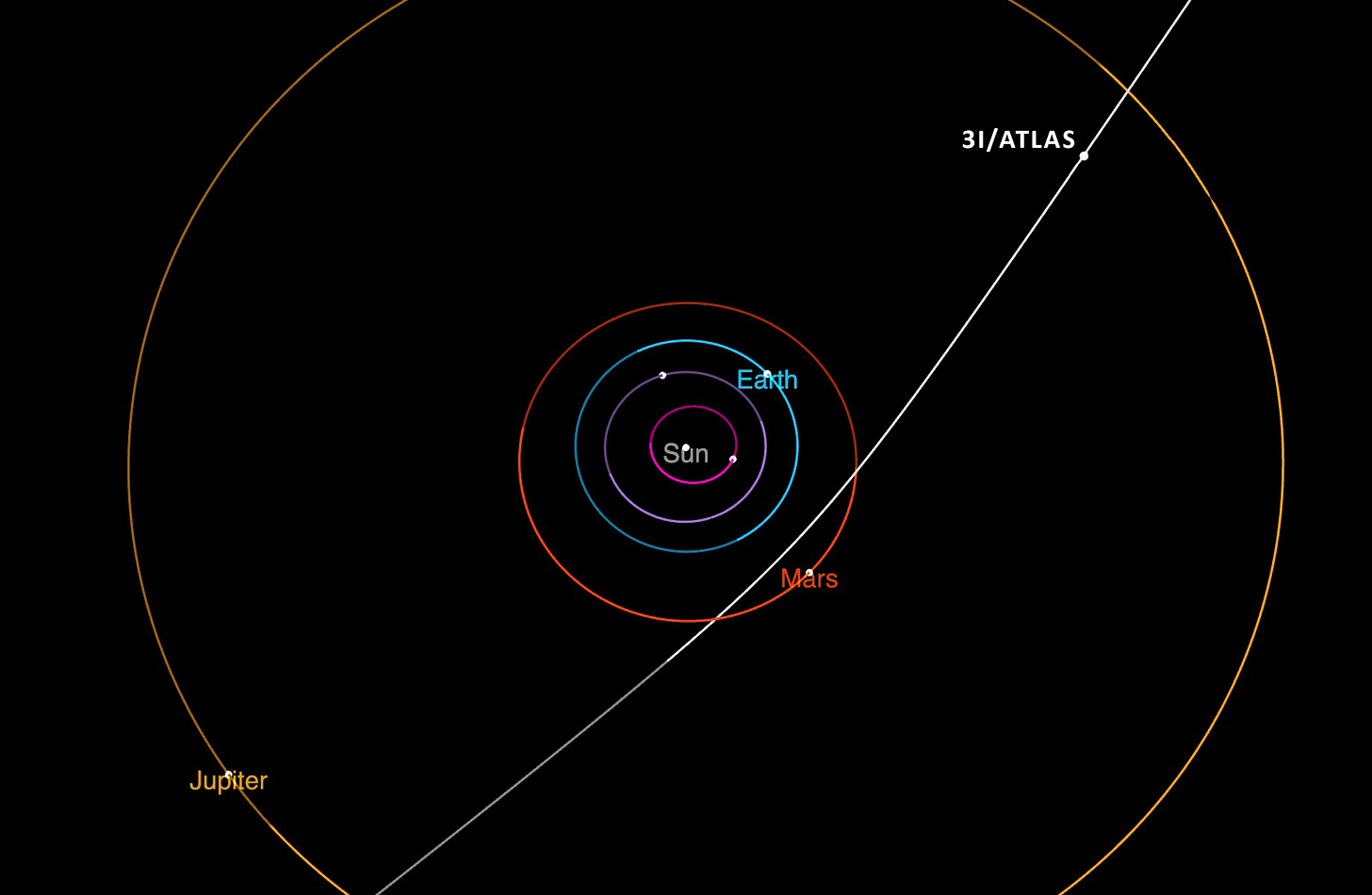Monday Musings #120 🤬
Musings on 3I/ATLAS
Good Monday, Gamer!
“The universe is under no obligation to make sense to you.”
— Neil deGrasse Tyson
Now for something… Completely out of this world!
Now and again, an IRL event lands that feels tailor-made for TTRPGs. I present to you, gamer: 3I/ATLAS.
Like Mulder, I too want to believe. But I’m no rube. I’ve been following this story for a while now, watching the updates roll in as this thing sped past Mars and then slid behind the Sun. If you were writing a probe into your campaign—something that arrives hot, sweeps the inner system, ducks out of line-of-sight, and reappears with new behavior—this is how you’d stage it. So before the invasion takes place (kidding… mostly), here’s how to use it at the table. (Sky at Night Magazine)
I dig Dr. Avi Loeb for asking the career-ending questions in public and staying curious—plus “I don’t know, we need more data” is a vibe. The mix of good data, open controversy, and cosmic mystery is chef’s kiss. (Live Science)
3I/ATLAS as TTRPG Hook
Astronomers identified 3I/ATLAS on July 1, 2025—the third confirmed interstellar object to dip through our neighborhood after ’Oumuamua and Borisov. It’s inbound, active, and behaving enough like a comet that the “professional” consensus is “natural visitor,” not “danger probe,” with closest-to-Sun around Oct 30, 2025, and no close pass to Earth (it stays ~170 million miles away). That still leaves an ocean of story space to play in.
Early spectra and imaging gave us real weirdness to chew on. A CO₂-dominated coma (unusual compared to many comets) showed up in JWST data; there’s water, CO, dust—plenty to model and argue about. It brushed past Mars in early October, then went behind the Sun from Earth’s perspective and should pop back out into the morning sky toward December with a drive-by on Jupiter...assuming it doesn’t get all tricksy while it’s behind the Sun!. Tell me that doesn’t read like “deliberate route with a blackout window.”
Loeb floated the speculative idea that 3I/ATLAS could be artificial—even linking it, hypothetically, to the 1977 Wow! Signal—and he’s tied that thread to his team’s recovery of odd spherules from the Pacific that he argues are interstellar in origin. The mainstream response has been… skeptical. Which, for GMs, is perfect: factions, claims, counterclaims, and a clock ticking as the object speeds on. (Live Science) [Also, NASA is subject to the government shutdown and is “down” during the objects’ fly-by on Mars!!]
So what do we get if we treat 3I/ATLAS as a game event? An anomalous visitor, narrow observation windows, signal noise, competing agendas, and the chance that what you learn won’t be the whole truth. In other words: Baby, that’s an Adventure!
Cosmic Tensions
Is it natural or artificial? That’s the core question. Leave it open long enough for players to invest in their own theories.
Does it carry intelligence or payload? Maybe Von Neumann probes, a compromised alien AI, a lure. The science pros say “comet”; our scenarios can say “what if.”
Timing and observation windows matter. A pass by Mars, a solar blackout, a December re-emergence—your clock writes itself.
Multiple factions circle the object: agencies, universities, private space, cults, defense, and billionaires with telescopes. Mages, Liches. Everyone wants data; nobody wants to share. Risk of contact can be mundane (propellant, dust, contamination) or spooky (odd radiation, probability “warps,” dream-signals). Keep the real risks grounded; let the weird leak in at the edges. Public panic vs. secrecy is its own game. Who controls the narrative? Who leaks? Who disappears?
Uncertainty is a feature. Your players might walk away with shards of truth and a long tail of consequences, enemies, and strange friends.
Real-World Anchors
Use the Wow! Signal as your mythic baseline: a 72-second narrowband “hello?” in 1977 that never repeated and was never explained. Make your table chase a brief, maddening repeat while 3I/ATLAS is in view.
Borrow Loeb’s ocean spherules as physical MacGuffins—tiny, stubborn beads that won’t quite match terrestrial profiles. Then seed in the rebuttals and debunks to fuel intra-party debates and NPC conflicts. I’d put a whole scout craft crash under the sea!
Ground the spectacle with actual observing arcs (Mars flyby, perihelion, Sun blackout, December return). The more you root the timing in reality, the more the weird parts feel earned.
Genres
Hard Sci-Fi / Space Opera. A small team gets a one-shot intercept during the Mars window to tag the object and gather data before it goes dark behind the Sun. Corporate rivals launch a clandestine countermission. The moral question: publish open data, or sell the advantage?
Modern Cosmic Horror. A drifting object arrives in orbit. Short, narrow radio bursts sync with the object’s changing phase angle. It pulses with signals. It warps probability locally. PCs investigate cults, signal noise, weird dreams.
Near-Future Tech Thriller. Space agencies and private contractors fight over tracking time, downlink keys, and sample custody. Your crew gets hired for a “chain-of-evidence” retrieval at sea after a fragment is netted by accident. The op goes sideways when a second boat arrives with better funding and fewer scruples.
Pulp / Weird Adventure. The “comet” sheds beads that fall along a ley-line chain. The object is more mystical — a celestial orb with runes etched upon it. It may be a key, a map, or a key for a portal. Cults, relic-hunters, and strange guardians battle.
Fantasy / Magical Realism. A star-fall reliquary arrives from beyond known planes. It’s partially alien magic, partially technology. Wizards, planar guardians, and scholars flock to it.
Post-Apocalyptic. The sky visitor lights up old satellites that were dead to you. Your settlement’s power grid stutters in rhythmic pulses. A faction insists it’s a sign to abandon the valley before “the shadow of noon.” Is it radiation? Is it someone pinging a lost network? Who benefits if you move?
Body Horror. A lab tech drops a spherule. It unwinds into a hair-thin filament and creeps toward the nearest heat source. It’s not alive—exactly—but it is programmed. By who? To do what? By the time you bag it, three more are missing.
GM Advice
Don’t overexplain. Let your players build theories. Reward investigation with fragments—good, conflicting, tantalizing fragments of data.
Use a clock. Mars window. Sun blackout. December return. Each tick changes what’s possible.
Play at multiple scales. Ground teams. Lab teams. Antenna time. Orbital assets. Cross-cut scenes like a heist.
Keep factions messy. No pure villains, no perfect saints—only budgets, beliefs, and blind spots. Factions aren’t clearly good or evil. It’s FOMO, baby!
Let the object change. New jets. A kink in the tail. A one-off signal. New behavior after perihelion. The map updates; so does the mystery.
Further Reading
NASA Science — Comet 3I/ATLAS overview & trajectory. (NASA Science)
Planetary Society — What we know about 3I/ATLAS. (Planetary Society)
JWST paper — CO₂-dominated coma (arXiv). (arXiv)
Mars pass & solar conjunction timing (news/sky guides). (AP News)
Wow! Signal background. (Nature)
Loeb’s speculative takes / spherules. (Medium)
Thanks for reading, playing, and supporting the strange stuff.


